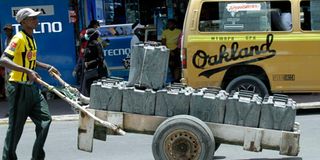Coast city battles trash, water shortages as projects drag on

A water vendor passes along the Digo Road in Mombasa on March 12, 2022.
The Mombasa gubernatorial battle is turning out to be a contest between aspirants on who can solve the perennial water shortage and garbage menace that have haunted Kenya’s top tourism resort for ages.
Governor Hassan Joho had promised to resolve the garbage problem but, as he finalises his second and final term in office, disposal of waste is still a challenge in most city estates.
And those seeking to succeed Mr Joho — Mr Abdulswamad Nassir (Orange Democratic Movement, ODM), Mr Mike Sonko (Wiper Party), Mr Hassan Omar (United Democratic Alliance) and Dr William Kingi (Pamoja African Alliance) have all pledged to initiate projects to tackle the two issues.
On water, Mr Nassir has promised to install purification systems in every public school. On the garbage problem, the ODM candidate promises to set up a garbage recycling plant that will convert it into energy and to start selling power directly.
Dams project
Mr Sonko said his administration will redesign the city and fix the drainage system. “I’ll engage the national government and other partners to build water infrastructure,” the former Nairobi Governor said at the launch of his 10-point political agenda.
Mr Omar said his administration would partner with the national government to oversee completion of dam projects.
Desalination “will ensure every household has access to clean water,” he said.
Dr Kingi said the Mwakirunge dumpsite poses a challenge as currently used. The Joho administration had promised to set up a Sh6.5 billion garbage recycling plant and a Sh16 billion desalination plant.
Two months to the August 9 General Election, however, the projects that were to start in 2019 are yet to kick off.
Lack of a freshwater source in Mombasa and the neighbouring counties has been a problem for years. The county government blames the national government for delays in approving set-up of the plant on 60 acres in Mwakirunge, Kisauni, to recycle waste into usable products.
“We were promised schools and health centres by the county government, but what we got was a dumping site and, due to the poisonous filth here, our health is at risk,” a resident, Ms Hamisi Karisa, told the Nation.
In 2018, the devolved unit shut down the Kibarani dumpsite, transforming it into an Sh700 million recreational park with help from Mombasa Cement Company. But there were no strategies on where to take the waste. The county government then turned to the VOK dumpsite in Bombolulu, which is in a residential area.
Perimeter wall
The residents protested at the stench emanating from the area, leading to its closure as the county reverted to Mwakirunge.
“We’ve protested several times. County officials came and promised to set up a perimeter wall, but instead, they deployed additional trucks to dump the garbage here,” Ms Mercy Kitsao said.
Stakeholders in the tourism and hotel industries have raised concern about the garbage problem and have asked the relevant county departments to address the issue urgently.
“It’s not just a threat to tourism, it’s also a health hazard to residents of this beautiful resort city. Sadly, we’ve talked about this for the past 10 years and we’ve even suggested policy changes to address challenges that destroy the aesthetics of the city.
“Maybe everyone has gone to campaigns and the city is on autopilot, “said the Kenya Association of Hotelkeepers and Caterers Coast Executive Director, Dr Sam Ikwaye.





